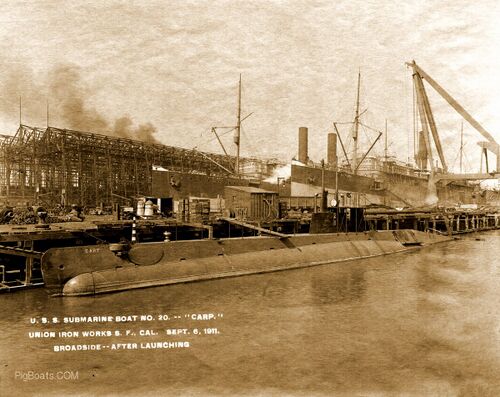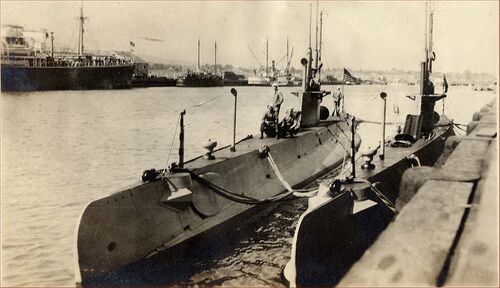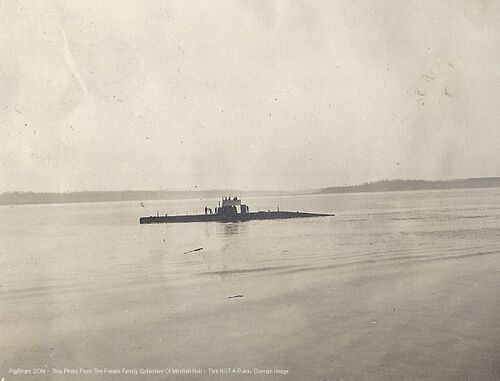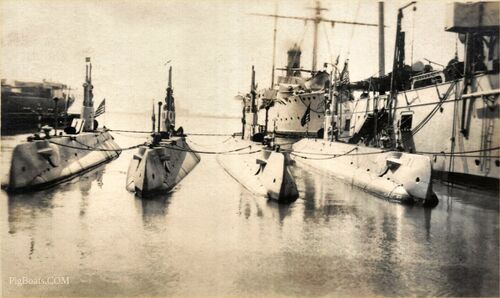F-class
Design, Construction, and Naming Notes
These four boats were the first submarines to operate out of Hawaii. They were based at Piers 5 and 5A in Honolulu, as the facilities in Pearl Harbor were still in a nascent stage and under construction. Although generally well regarded, by November 1915 they were badly in need of a full Navy yard overhaul and Pearl was still not ready for them. In the aftermath of the F-4 disaster they were towed back to Mare Island Navy Yard and after several months of lying in partial commission (in ordinary status) they were overhauled and put back into full service, with F-2 and F-3 serving well until 1922. F-1 was lost in a collision with F-3 while on maneuvers off San Diego in 1917.
Carp/F-1 (Submarine No. 20)

Barracuda/F-2 (Submarine No. 21, later SS-21)

Pickerel/F-3 (Submarine No. 22, later SS-22)

Skate/F-4 (Submarine No. 23)

General F-class Photos

Though the names on the hull are indistinct, on a few submarines the shape of the bow planes pivot covers help separate the vessels into where each was built. The two outer submarines have covers with sloping top and bottoms and were built at Union Iron Works in San Francisco. (F1 and F-2). The two middle submarines have covers with flat tops and bottoms and were built at the Moran Company in Seattle, Washington. (F-3 and F-4) These features remained the same through their whole careers.
Though this is a really great image of the four F-class submarines, the real interesting story is taking place just behind them. The vessel seen astern of the Alert is the German unprotected cruiser SMS Geier, as seen in other photos. After the U.S. entered WW I the Geier was seized by the U.S. and pressed into service as the USS Schurz. She later sank in a ramming on the U.S. east coast.
The vessel on the left is thought to be the German steamship Locksun (ex-German SS Andree Rickmers), that had been pressed into service as a collier for the Geier. She took refuge a day or so later than the Geier from the Japanese battleship Hizen, who was attempting to locate the German ships in Hawaiian waters. Locksun was not an interned ship at first because her connection with Geier was not known at the time. Locksun even took prisoners from the sunken German power schooner Aeolus from Hizen and brought them aboard the Locksun. Once her connection was known she was interned as well. After the U.S. entered the war she was renamed the USS Gulfport (AK-5) and remained in U.S. service until 1922.
It is interesting to note that as soon as the U.S. entered WW I all interned ships in U.S. ports around the world tried to destroy their engines and/or scuttle the ships in harbors to block them. Geier set fire to her engine room and boilers. Locksun damaged her engines.
Directly behind the F-3, (second from left) can be seen the Honolulu Harbor Light Station lighthouse on Sand Island. On the deck of the F-3 there is a crewman lounging with his back leaning against the conning tower fairwater in the shade.
See more General F-class photos
Page created by:
Ric Hedman & David Johnston
1999 - 2023 - PigBoats.COM©
Mountlake Terrace, WA, Norfolk, VA
webmaster at pigboats dot com
